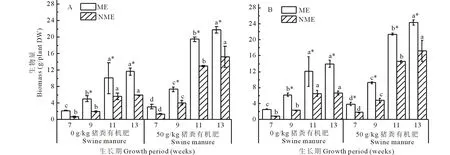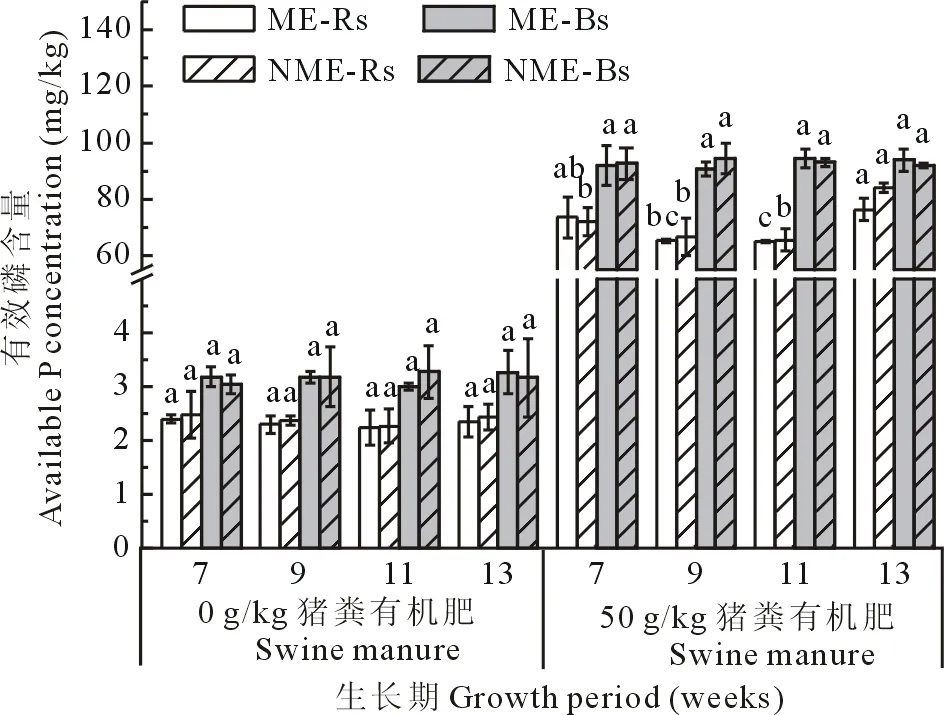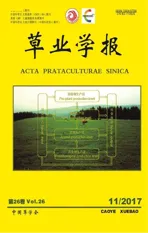猪粪有机肥施用下两种生态型粗齿冷水花磷积累特征变化
2017-11-24陈静黄有胜李廷轩
陈静,黄有胜,李廷轩*
(1.四川农业大学资源学院,四川 成都 611130;2.四川省农业机械化干部学校,四川 成都 610017)
猪粪有机肥施用下两种生态型粗齿冷水花磷积累特征变化
陈静1,黄有胜2,李廷轩1*
(1.四川农业大学资源学院,四川 成都 611130;2.四川省农业机械化干部学校,四川 成都 610017)
猪粪的不合理施用导致土壤中磷素大量积累,引起一系列环境问题。研究磷富集植物在猪粪条件下的磷积累变化特征,可以为提取土壤中过量的磷提供理论依据。以矿山生态型粗齿冷水花为研究对象,非矿山生态型为对照,设置猪粪有机肥用量为50 g/kg,开展土培盆栽试验。结果表明:1)猪粪有机肥施用下,两种生态型粗齿冷水花地上部和整株生物量随生长时期的延长均在13周最高,且矿山生态型显著高于非矿山生态型(Plt;0.05),分别为非矿山生态型的1.43~2.26倍和1.41~2.20倍。2)粗齿冷水花地上部和整株阶段性磷积累速率均在9~11周最大。矿山生态型粗齿冷水花地上部和整株磷积累量均显著高于非矿山生态型(Plt;0.05),13周时其地上部和整株磷积累量分别达105.21和119.50 mg/株。3)猪粪有机肥的施用提高了土壤有效磷含量、酸性磷酸酶和植酸酶活性。随生长时期的延长,粗齿冷水花根际酸性磷酸酶和植酸酶活性均在11周最高,矿山生态型根际植酸酶活性显著高于非矿山生态型。猪粪有机肥施用下,矿山生态型粗齿冷水花生长状况和磷积累能力均强于非矿山生态型,其根际较高的酸性磷酸酶和植酸酶活性提高了土壤中磷素的生物有效性,促进了矿山生态型对磷的吸收积累。
猪粪有机肥; 磷积累; 生态型; 土壤酸性磷酸酶; 土壤植酸酶
近年来,随着畜禽养殖业的快速发展,畜禽粪便排放量日趋增加。据估算,2013年我国畜禽粪便产生量达14.87亿t,其中猪粪占20%以上[1]。猪粪磷含量达24.2~48.7 g/kg[2],而溶解性磷占21%~71%[3]。农业生产中猪粪的不合理施用导致土壤中磷大量积累[4],过剩的磷在降雨或农田排水作用下向水体迁移[5],加速水体的富营养化进程。因此,寻找适宜的方法减少土壤中过量的磷显得尤为迫切。
通过收获植物地上部以提取土壤中过量的磷被认为是一种有效的治理措施[6]。一年生黑麦草Marshall 和Gulf(Loliummultiflorum)[7]、澳洲狐尾草(Ptilotuspolystachyus)[8]、羊茅黑麦草Duo grass(Lolium×Festuca)[9]等体内磷含量可达10 g/kg,被认为是良好的磷富集植物。但研究发现,即使是同种富磷植物在高浓度无机磷、有机磷及鸡粪处理下,其生物量、磷含量均差异较大[7,10-11]。植物的生长状况及对磷的吸收在很大程度上受根际磷素有效性的影响[9]。有机磷约占土壤全磷的20%~80%[12],需经磷酸酶矿化分解后才能被植物吸收利用。酸性磷酸酶是一种非特异性磷酸单酯水解酶,能够将有机磷水解为无机磷,是促进植物磷吸收的一个重要因素[13]。植酸盐类化合物占土壤有机磷的比例达50%[14],而植酸酶对植酸态磷的水解具有高度的专一性。
粗齿冷水花(Pileasinofasciata)是一种多年生草本植物,可生长于陆地或湿地,具有较强的环境适应能力。前期研究表明,矿山生态型粗齿冷水花具有较强的磷积累能力,是一种良好的磷富集植物[15-18]。本研究在前期研究基础上,设置适宜猪粪有机肥用量,探讨矿山生态型粗齿冷水花不同生长时期磷积累特性,为后期合理利用粗齿冷水花提取环境中过量的磷提供理论参考。
1 材料与方法
1.1供试材料
供试植物:粗齿冷水花,矿山生态型(mining ecotype,ME)采自四川省什邡市磷矿区(104°50′ E,30°25′ N),非矿山生态型(non-mining ecotype,NME)采自雅安市雨城区(102°59′ E,29°58′ N)。
供试土壤:灰潮土,采自四川省都江堰市蒲阳镇双柏村。其基本理化性质为:pH 6.70、有机质20.62 g/kg、碱解氮33.95 mg/kg、有效钾32 mg/kg、有效磷3.55 mg/kg。
供试猪粪有机肥:采自四川省都江堰市蒲阳镇规模养殖场,经腐熟过筛后待用。基本理化性质为:pH 6.69、有机质495.1 g/kg、全氮13.88 g/kg、全磷25.62 g/kg、全钾3.05 g/kg。
1.2试验设计与处理
猪粪有机肥用量设置为50 g/kg(以干重计),以不施猪粪有机肥为对照,每处理重复12次,两种生态型共48盆,完全随机排列。采用土培试验,土壤经风干压碎过筛,与猪粪有机肥混匀后装于16 L塑料盆中,每盆装土15 kg,陈化4周待用,陈化后土壤基本理化性质见表1。
幼苗的培育及管理采用刘霜等[17]的方法。待幼苗生长30 d后,选择长势一致的植株移栽至盆中,每盆2株。采用自然光照,按田间持水量的70%确定灌水量。试验于2015年6-9月在四川农业大学教学科研园区有防雨设施的网室中进行。

表1 陈化后土壤基本理化性质Table 1 The physicochemical properties of soils used for the experiment
1.3样品采集与制备
于移栽后7、9、11、13周采样,植株经自来水冲洗,蒸馏水润洗后用吸水纸擦干,分为地上部和地下部,装袋后于105 ℃杀青30 min,75 ℃烘干至恒重,粉碎后备用。
采用抖土法收集根际土和非根际土。一部分土样存于4 ℃冰箱中,用于酸性磷酸酶和植酸酶活性的测定,另一部分风干磨碎过筛后用于有效磷含量的测定。
1.4测定项目及方法
土壤基本理化性质采用常规分析方法测定[19];植株生物量采用烘干称重法测定[19];植株磷含量采用微波消解仪(CEM-MARS5,USA)-全自动间断化学分析仪(SEAL-AQ2,UK)测定;土壤酸性磷酸酶活性采用磷酸苯二钠比色法测定[19];土壤植酸酶活性的测定参考Ramesh等[20]的方法。
阶段磷积累速率=阶段磷积累量/时间
1.5数据处理
采用DPS 11.0进行统计分析,选择LSD法进行多重比较,采用Origin 8.1制作图表。
2 结果与分析
2.1猪粪有机肥施用下矿山生态型粗齿冷水花生物量变化
由图1分析可知,猪粪有机肥施用下,粗齿冷水花地上部和整株生物量均明显高于对照,且不同生态型间差异显著(Plt;0.05)。矿山生态型粗齿冷水花地上部生物量显著高于非矿山生态型,为非矿山生态型的1.43~2.26倍;整株生物量为非矿山生态型的1.41~2.20倍。随着生长时期的延长,矿山生态型粗齿冷水花地上部和整株生物量显著增加,在11周前成倍增长,其后增长幅度逐渐趋缓,非矿山生态型粗齿冷水花的变化趋势与矿山生态型相似,且矿山生态型生物量增加量高于非矿山生态型。
2.2猪粪有机肥施用下矿山生态型粗齿冷水花阶段性磷积累速率变化
阶段性磷积累速率能够反映粗齿冷水花不同生长阶段的磷积累能力。由表2分析可知,猪粪有机肥施用下,两种生态型粗齿冷水花地上部和整株阶段性磷积累速率均明显高于对照,不同生态型间差异显著。矿山生态型粗齿冷水花地上部和整株阶段性磷积累速率在不同生长阶段显著高于非矿山生态型,分别为非矿山生态型的1.26~1.62倍和1.27~1.75倍。随生长时期的延长,矿山生态型粗齿冷水花阶段性磷积累速率呈先升高后降低的趋势,在9~11周达最高,非矿山生态型的变化趋势与矿山生态型相似。表明矿山生态型粗齿冷水花在7~13周的磷积累能力强于非矿山生态型,9~11周为矿山生态型粗齿冷水花积累磷的重要时期。
2.3猪粪有机肥施用下矿山生态型粗齿冷水花磷积累量变化
由表3分析可知,猪粪有机肥的施用极大地增强了两种生态型粗齿冷水花对磷的积累,矿山生态型粗齿冷水花表现尤为突出。猪粪有机肥施用下,矿山生态型粗齿冷水花地上部和整株磷积累量分别为对照的2.80~4.40倍和3.49~3.95倍,且与非矿山生态型间差异显著。矿山生态型粗齿冷水花不同生长时期地上部和整株磷积累量均显著高于非矿山生态型,分别为非矿山生态型的1.47~2.23倍和1.50~2.08倍。随生长时期的延长,两种生态型粗齿冷水花地上部和整株磷积累量显著增加,且矿山生态型粗齿冷水花磷积累量增加量高于非矿山生态型。13周时,矿山生态型粗齿冷水花地上部和整株磷积累量分别达105.21和119.50 mg/株。

图1 猪粪有机肥施用下两种生态型粗齿冷水花生物量差异Fig.1 Biomass of the two ecotypes of P. sinofasciata grown in soils amended with swine manure A:地上部;B:整株;ME:矿山生态型;NME:非矿山生态型,下同。柱上不同小写字母表示相同处理同种生态型不同生长时期之间差异显著(Plt;0.05),*表示相同处理下同一生长时期不同生态型之间差异显著(Plt;0.05)。A: Shoot; B: Whole plant; ME: Mining ecotypes; NME: Non-mining ecotypes, the same below. Different letters indicate significant difference between growth periods (Plt;0.05); * indicates significant difference between two ecotypes (Plt;0.05).

mg/(plant·d)
注:不同小写字母表示相同处理同种生态型不同生长时期之间差异显著(Plt;0.05),*表示相同处理下同一生长时期不同生态型之间差异显著(Plt;0.05),下同。
Notes: Different letters indicate significant difference between growth periods (Plt;0.05); * indicates significant difference between ecotypes (Plt;0.05). The same below.

表3 猪粪有机肥施用下两种生态型粗齿冷水花磷积累量差异Table 3 P accumulation of the two ecotypes of P. sinofasciata grown in soils amended with swine manure mg/plant
2.4猪粪有机肥施用下矿山生态型粗齿冷水花根际土壤有效磷含量变化

图2 猪粪有机肥施用下两种生态型粗齿冷水花根际和非根际土壤有效磷含量差异Fig.2 Soil available P in the rhizosphere and bulk soils of the two ecotypes of P. sinofasciata grown in soils amended with swine manure Rs:根际土壤; Bs:非根际土壤, 柱上不同小写字母表示相同土壤类型同一生态型不同生长时期间差异显著(Plt;0.05), *表示相同土壤类型同一生长时期不同生态型间差异显著(Plt;0.05),下同。Rs: Rhizosphere soil; Bs: Bulk soil. Different letters above the bars indicate significant difference between growth periods (Plt;0.05). * indicates significant difference between two ecotypes (Plt;0.05). The same below.
由图2分析可知,猪粪有机肥施用下,粗齿冷水花根际和非根际土壤有效磷含量均远高于对照,且根际土壤有效磷含量低于非根际土壤。随生长时期的延长,两种生态型粗齿冷水花根际土壤有效磷含量呈先降低后升高的趋势,在11周后显著增加,非根际土壤有效磷含量无显著变化。矿山生态型根际和非根际有效磷含量与非矿山生态型差异不显著。
2.5猪粪有机肥施用下矿山生态型粗齿冷水花根际土壤酸性磷酸酶和植酸酶活性变化
由图3分析可知,猪粪有机肥的施用提高了土壤酸性磷酸酶和植酸酶活性,且对植酸酶活性的提升作用明显强于酸性磷酸酶。猪粪有机肥施用下,矿山和非矿山生态型粗齿冷水花根际土壤植酸酶活性分别为对照的6.62~7.15倍和6.03~6.73倍。随生长时期的延长,两种生态型粗齿冷水花根际土壤酸性磷酸酶和植酸酶活性均呈先升高后降低的趋势,在11周达最高。矿山生态型粗齿冷水花根际土壤酸性磷酸酶活性与非矿山生态型差异不显著,但矿山生态型根际土壤植酸酶活性显著高于非矿山生态型,为非矿山生态型的1.06~1.16倍。

图3 猪粪有机肥施用下两种生态型粗齿冷水花根际土壤酸性磷酸酶和植酸酶活性差异Fig.3 Acid phosphatase and phytase activities in the rhizosphere of the two ecotypes of P. sinofasciata grown in soils amended with swine manure
3 讨论
3.1猪粪有机肥施用下矿山生态型粗齿冷水花磷积累特征变化
植物的生长和对磷的吸收积累在很大程度上受生长时期的影响[9,21],营养生长旺盛时期,植物阶段性磷积累速率最高,对植株磷积累量的贡献最大[22-24]。小麦(Triticumaestivum)[23,25]和水稻(Oryzasativa)[23]磷素吸收积累高峰期出现在拔节期,其阶段性磷积累量高于拔节前和成熟期。矿山生态型粗齿冷水花阶段性磷积累速率在9~11周最高,这与根际土壤酸性磷酸酶和植酸酶活性(图3)的变化趋势基本一致,表明9~11周为矿山生态型生长代谢最旺盛的时期,同时也是磷吸收积累的重要时期。磷积累量在一定程度上可以反映植物修复的效率[26]。猪粪有机肥施用下,矿山生态型粗齿冷水花地上部磷积累量达105.21 mg/株,相比牧草如Duo grass[9]、Marshall和Gulf[11]等更具磷提取优势。矿山生态型水蓼(Polygonumhydropiper)在不同用量猪粪处理下地上部磷积累量最高也仅为65.94 mg/株[27]。可见,矿山生态型粗齿冷水花具有较强的磷积累能力和较高的植物修复效率。粗齿冷水花是一种多年生草本植物,多次收获其地上部有利于提取土壤中过量的磷,而选择适宜的收获时期是提高磷去除效率的重要手段。13周时,矿山生态型粗齿冷水花地上部磷积累速率显著降低,且多数已出现开花现象,因此认为粗齿冷水花的最佳收获时期在13周前。
3.2猪粪有机肥施用下矿山生态型粗齿冷水花根际土壤有效磷与酶活性变化
由于根系对磷的吸收能力和对根际磷的活化或矿化能力存在差异,不同植物根际有效磷含量差异较大[13,28-29]。磷高效油菜(Brassicanapus)、大麦(Hordeumvulgare)等对磷的吸收作用较强,其根际有效磷含量明显低于磷低效品种或普通品种[13,30]。矿山生态型粗齿冷水花磷积累量显著高于非矿山生态型,但二者根际有效磷含量差异不显著,这可能是由于矿山生态型根系磷吸收积累能力强于非矿山生态型,其一方面不断大量的吸收土壤中的磷,另一方面通过根系向环境中分泌磷酸酶,促进了根际环境中有机磷的矿化,进而缓解了根际有效磷含量的降低[31]。酸性磷酸酶是矿化土壤有机磷和提高土壤磷素生物有效性的关键性酶之一[32],而植酸酶能够专一性水解植酸态磷[10]。植物根系分泌酸性磷酸酶是其适应低磷环境,提高自身磷吸收潜力的重要途径之一[13]。本研究却发现矿山生态型粗齿冷水花根际土壤酸性磷酸酶活性在猪粪有机肥施用下高于对照。在对大麦的研究中发现,磷高效野生大麦根际土壤酸性磷酸酶活性随有机磷浓度的增加显著增加[13];矿山生态型水蓼根际土壤酸性磷酸酶活性同样表现为猪粪处理高于不施猪粪处理[31]。根际土壤植酸酶活性的变化趋势与酸性磷酸酶相似。矿山生态型粗齿冷水花根际土壤植酸酶活性在猪粪有机肥施用下远高于对照,这可能与施入猪粪有机肥后土壤中磷的赋存形态有关。土壤中植酸态磷约占土壤有机磷的50%,且猪粪中的有机磷也主要以植酸态形式存在[2]。以植酸磷为唯一磷源条件下,植物根系能够分泌大量植酸酶来水解植酸磷以满足自身对磷的吸收利用[33]。以上研究表明,矿山生态型粗齿冷水花根际较高的酸性磷酸酶和植酸酶活性有利于其提高土壤磷素生物有效性,促进植物对磷的吸收积累。
4 结论
矿山生态型粗齿冷水花生物量、阶段性磷积累速率和磷积累量均显著高于非矿山生态型,13周时其地上部和整株磷积累量分别达105.21和119.50 mg/株。相比非矿山生态型,矿山生态型粗齿冷水花磷积累能力更强。
猪粪有机肥的施用提高了土壤酸性磷酸酶和植酸酶活性,矿山生态型粗齿冷水花根际植酸酶活性显著高于非矿山生态型。猪粪有机肥施用下,矿山生态型粗齿冷水花根际较高的植酸酶活性是其富集磷的重要机制之一。
References:
[1] Yao S, Wang G Y. Study on estimation and warning of farmland load of livestock and poultry——Based on zoning perspective. Journal of Huazhong Agricultural University (Social Sciences Edition), 2016, 121(1): 72-84.
姚升, 王光宇. 基于分区视角的畜禽养殖粪便农田负荷量估算及预警分析. 华中农业大学学报(社会科学版), 2016, 121(1): 72-84.
[2] Pagliari P H, Laboski C A M. Investigation of the inorganic and organic phosphorus forms in animal manure. Journal of Environmental Quality, 2012, 41(3): 901-910.
[3] Luo C Y, Ji H J, Zhang W L,etal. Readily soluble phosphorus characterization in duck and swine manures. Journal of Agro-Environment Science, 2008, 27(4): 1320-1325.
罗春燕, 冀宏杰, 张维理, 等. 鸭粪和猪粪中易溶性磷含量特征研究. 农业环境科学学报, 2008, 27(4): 1320-1325.
[4] Xue Q Y, Shamsi I H, Sun D S,etal. Impact of manure application on forms and quantities of phosphorus in a Chinese cambisol under different land use. Journal of Soils and Sediments, 2013, 13(5): 837-845.
[5] Kleinman P J A, Sharpley A N, Wolf A M,etal. Developing an environmental manure test for the phosphorus index. Communications in Soil Science and Plant Analysis, 2006, 37(15): 2137-2155.
[6] Novak J M, Chan A S K. Development of P-hyperaccumulator plant strategies to remediate soils with excess P concentrations. Critical Reviews in Plant Sciences, 2002, 21(5): 493-509.
[7] Sharma N C, Sahi S V. Characterization of phosphate accumulation inLoliummultiflorumfor remediation of phosphorus-enriched soils. Environmental Science and Technology, 2005, 39(14): 5475-5480.
[8] Ryan M H, Ehrenberg S, Bennett R G,etal. Putting the P inPtilotus: a phosphorus-accumulating herb native to Australia. Annals of Botany, 2009, 103(6): 901-911.
[9] Padmanabhan P, Starnes D L, Sahi S V. Differential responses of Duo grass (Lolium×Festuca), a phosphorus hyperaccumulator to high phosphorus and poultry manure treatments. African Journal of Biotechnology, 2013, 12(21): 3191-3195.
[10] Sharma N C, Sahi S V. Enhanced organic phosphorus assimilation promoting biomass and shoot P hyperaccumulations inLoliummultiflorumgrown under sterile conditions. Environmental Science and Technology, 2011, 45(24): 10531-10537.
[11] Starnes D L, Padmanabhan P, Sahi S V. Effect of P sources on growth, P accumulation and activities of phytase and acid phosphatases in two cultivars of annual ryegrass (LoliummultiflorumL.). Plant Physiology and Biochemistry, 2008, 46(5): 580-589.
[12] Xiang W S, Huang M, Li X Y. Progress on fractioning of soil phosphorus and availability of various phosphorus fractions to crops in soil. Journal of Plant Nutrition and Fertilizer, 2004, 10(6): 663-670.
向万胜, 黄敏, 李学垣. 土壤磷素的化学组分及其植物有效性. 植物营养与肥料学报, 2004, 10(6): 663-670.
[13] Cai Q Y, Zhang X Z, Li T X,etal. The utilization of phytate organic phosphorus in P-efficient wild barley genotypes at jointing stage. Scientia Agricultura Sinica, 2015, 48(16): 3146-3155.
蔡秋燕, 张锡洲, 李廷轩, 等. 磷高效野生大麦拔节期对植酸态有机磷的利用. 中国农业科学, 2015, 48(16): 3146-3155.
[14] Turner B L, Papházy M J, Haygarth P M,etal. Inositol phosphates in the environment. Philosophical Transactions of the Royal Society of London, 2002, 357: 449-469.
[15] Xiao G, Li T, Zhang X,etal. Uptake and accumulation of phosphorus by dominant plant species growing in a phosphorus mining area. Journal of Hazardous Materials, 2009, 171(1): 542-550.
[16] Zheng Z C, Li T X, Zhang X Z,etal. Phosphorous accumulation and distribution of two ecotypes ofPileasinofasciata, grown in phosphorous-enriched soils. Applied Soil Ecology, 2014, 84(84): 54-61.
[17] Liu S, Li T X, Ji L,etal. Phosphorus accumulation and root morphological difference of two ecotypes ofPileasinofasciatagrown in different phosphorus treatment. Acta Prataculturae Sinica, 2013, 22(3): 211-217.
刘霜, 李廷轩, 戢林, 等. 不同磷处理下两种生态型粗齿冷水花的富磷特征及根系形态差异. 草业学报, 2013, 22(3): 211-217.
[18] Ye D, Li T, Zhang X,etal. P uptake characteristics and P removal potentials ofPileasinofasciatagrown under soils amended with swine manure. Ecological Engineering, 2014, 73: 553-559.
[19] Lu R K. Analytical Methods of Soil and Agrochemistry[M]. Beijing: Chinese Agricultural Science and Technology Press, 2000.
鲁如坤. 农业化学分析[M]. 北京: 中国农业科技出版社, 2000.
[20] Ramesh A, Sharma S K, Joshi O P,etal. Phytase, phosphatase activity and P-nutrition of soybean as influenced by inoculation of bacillus. Indian Journal of Microbiology, 2011, 51(1): 94-99.
[21] Wang S Q, Han X Z, Yan J,etal. Impact of phosphorus deficiency stress on root morphology, nitrogen concentration and phosphorus accumulation of soybean (GlycinemacL.). Chinese Journal of Soil Science, 2010, 41(3): 644-650.
王树起, 韩晓增, 严君, 等. 缺磷胁迫对大豆根系形态和氮磷吸收积累的影响. 土壤通报, 2010, 41(3): 644-650.
[22] Peng Z P, Zhang J T, Yuan S,etal. Effect of different phosphorus application rates on the dynamic accumulation and distribution of dry matter and phosphorus in maize. Journal of Plant Nutrition and Fertilizer, 2009, 15(4): 793-798.
彭正萍, 张家铜, 袁硕, 等. 不同供磷水平对玉米干物质和磷动态积累及分配的影响. 植物营养与肥料学报, 2009, 15(4): 793-798.
[23] Li H W, Yang K P, Cao Z Q,etal. Characteristics of nutrient uptake and accumulation in wheat and rice with continuous cropping under Super-High-Yielding cultivation. Acta Agronomica Sinica, 2013, 39(3): 464-477.
李鸿伟, 杨凯鹏, 曹转勤, 等. 稻麦连作中超高产栽培小麦和水稻的养分吸收与积累特征. 作物学报, 2013, 39(3): 464-477.
[24] Xiao Q, Yan L B, Zhu X Y,etal. Dynamic analysis of dry matter and N P K accumulation with time in summer maize. Journal of Plant Nutrition and Fertilizer, 2014, 20(3): 606-612.
肖强, 闫连波, 朱欣宇, 等. 夏玉米植株干物质、氮磷钾养分积累速度和时间的动态分析. 植物营养与肥料学报, 2014, 20(3): 606-612.
[25] He W S, He J Q, Guo R Y. Characteristics of N, P and K uptake at different growth stages of spring wheat in irrigating region of Ningxia. Journal of Plant Nutrition and Fertilizer, 2006, 12(6): 789-796.
何文寿, 何进勤, 郭瑞英. 宁夏引黄灌区春小麦不同生育期吸收氮、磷、钾养分的特点. 植物营养与肥料学报, 2006, 12(6): 789-796.
[26] Pant H K, Mislevy P, Rechcigl J E. Effects of phosphorus and potassium on forage nutritive value and quantity. Agronomy Journal, 2004, 96(5): 1299-1305.
[27] Ye D, Li T, Chen G,etal. Influence of swine manure on growth, P uptake and activities of acid phosphatase and phytase ofPolygonumhydropiper. Chemosphere, 2014, 105(3): 139-145.
[28] Richardson A E, Barea J M, Mcneill A M,etal. Acquisition of phosphorus and nitrogen in the rhizosphere and plant growth promotion by microorganisms. Plant and Soil, 2009, 321(1): 305-339.
[29] Tang B, Zhang X Z, Yang X B. Effects of tobacco garlic crop rotation and intercropping on tobacco yield and rhizosphere soil phosphorus fractions. Chinese Journal of Applied Ecology, 2015, 26(7): 1977-1984.
唐彪, 张锡洲, 阳显斌. 烟蒜轮作与套作对烤烟产量及根际土壤磷组分的影响. 应用生态学报, 2015, 26(7): 1977-1984.
[30] Wang W H, Zhou X B, Zhou Y X,etal. The mechanism of rhizosphere phosphorus activation of two rape genotypes (BrassicanapusL.) with different P efficiencies. Journal of Plant Nutrition and Fertilizer, 2011, 17(6): 1379-1387.
王文华, 周鑫斌, 周永祥, 等. 不同磷效率油菜根际土壤磷活化机理研究. 植物营养与肥料学报, 2011, 17(6): 1379-1387.
[31] Ye D, Li T, Yu H,etal. P accumulation ofPolygonumhydropiper, soil P fractions and phosphatase activity as affected by swine manure. Applied Soil Ecology, 2015, 86: 10-18.
[32] Spohn M, Kuzyakov Y. Distribution of microbial- and root-derived phosphatase activities in the rhizosphere depending on P availability and C allocation-Coupling soil zymography with14C imaging. Soil Biology and Biochemistry, 2013, 67: 106-113.
[33] Fang X P, Wang Z, Chen R M,etal. TransgenicBrassicanapusgrowing with phytate as a sole phosphorus source. Acta Agronomica Sinica, 2010, 36(2): 228-232.
方小平, 王转, 陈茹梅, 等. 能以植酸磷为唯一磷源生长的转基因甘蓝型油菜. 作物学报, 2010, 36(2): 228-232.
PhosphorousaccumulationcharacteristicsoftwoecotypesofPileasinofasciatagrowninsoilsamendedwithswinemanure
CHEN Jing1, HUANG You-Sheng2, LI Ting-Xuan1*
1.College of Resources, Sichuan Agricultural University, Chengdu 611130, China; 2.Sichuan Agricultural Mechanization Cadre School, Chengdu 610017, China
Phosphorus (P) accumulation in soil due to excessive use of swine manure causes a series of environmental problems. In order to provide a sound basis for attempts to remove excess P, a study has been undertaken of its accumulation characteristics in two ecotypes ofPileasinofasciata. A mining ecotype (ME) and a non-mining ecotype (NME) were grown in soils amended with 50 g/kg swine manure. The results were as follows. 1) The biomass of the shoot and whole plant increased during the growth periods recorded, reaching maximum values at the 13th week. The ME shoot and whole plant biomass were 1.43-2.26 and 1.41-2.20 times higher than that of NME respectively (Plt;0.05). 2) The P accumulation rate of the shoot and whole plant in the two ecotypes reached their maximum values at the 9th-11th week. The P accumulation in ME shoot and whole plant were significantly higher than that of NME (Plt;0.05), and up to 105.21 and 119.50 mg/plant at the 13th week respectively. 3) Soil available P and the activities of acid phosphatase and phytase increased with the application of swine manure. The acid phosphatase and phytase activities in the rhizosphere soils of the two ecotypes reached their maximum values at the 11th week. The phytase activities in the ME rhizosphere soils were significantly higher than those of NME. These results demonstrate that the ME presented better growth and greater P accumulation when grown in soils amended with swine manure. The greater rhizosphere acid phosphatase and phytase activities in the ME rhizosphere soils contributed significantly to the availability of soil P, thus promoting P accumulation inP.sinofasciata.
swine manure; P accumulation; ecotype; soil acid phosphatase; soil phytase
10.11686/cyxb2017044http//cyxb.lzu.edu.cn
陈静, 黄有胜, 李廷轩. 猪粪有机肥施用下两种生态型粗齿冷水花磷积累特征变化. 草业学报, 2017, 26(11): 139-146.
CHEN Jing, HUANG You-Sheng, LI Ting-Xuan. Phosphorous accumulation characteristics of two ecotypes ofPileasinofasciatagrown in soils amended with swine manure. Acta Prataculturae Sinica, 2017, 26(11): 139-146.
2017-02-16;改回日期:2017-04-10
国家自然科学基金(41671323)和四川省科技支撑计划(2013NZ0044)资助。
陈静(1992-),女,四川德阳人,在读硕士。E-mail: jingclv@163.com
*通信作者Corresponding author. E-mail: litinx@263.net
